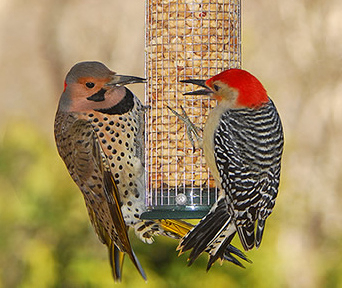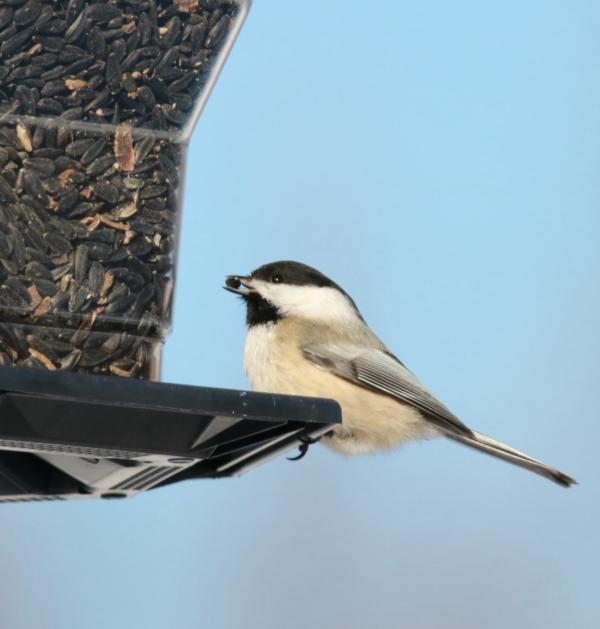 Woodpeckers such as this Northern Flicker and Red-bellied Woodpecker will be attracted sunflower seeds, suet, and peanuts.  Even small birds like Black-capped and Carolina Chickadees prosper from eating black oil sunflower seeds, which have the highest food value of any seeds. |
You have probably done some of your own research into what seeds the birds in your neighborhood prefer – it’s a natural part of feeding and observing birds. There are 7 to 10 different kinds of seeds that can come in a bag of mixed seeds, but let’s face it, some are low-cost filler seeds that make mixed seeds look like the best kind of bird buffet – but that’s not really the best option for the birds, or for you. Many veteran birders who have essentially ‘tried them all,’ tend to concentrate their bird seed offerings on 2 primary seeds – black oil sunflower seeds and thistle seeds (sometimes marketed as nyjer seeds).
It's no coincidence that these 2 types of seeds have the highest oil and food value content, which is why birds prefer them when they are available. The small size of thistle seeds dictates that smaller birds prefer them, especially goldfinches and some other winter finches such as Pine Siskins. But these finches also relish sunflower “chips” that have been cut into smaller pieces that provide food for small birds, along with large seed eaters that prefer sunflower seeds.
We think that simple is best in this case, and that simple also translates into easier – and that’s the case when offering black oil sunflower seeds and thistle seeds. Personally, we also like to offer peanut pieces, preferred by the jays that we enjoy seeing, and woodpeckers, nuthatches, and a few other birds like peanut chips too.
Most larger cities have “wild bird stores” where we can get expert advice and purchase a variety of seed options. Even some large hardware stores and department stores stock a surprising variety of seed mixes to choose from, but it’s always worthwhile to do a little comparison shopping – comparing weights and prices of packaged seed mixes – along with a little “field research” at your feeding station.
Shelled Options
The nice thing about sunflower chips is that they have been shelled, hence there is the no waste factor, and no messy shells that eventually cover the ground and pile up until you get out a broom and shovel to clean up. With shelled seeds, there is no mess, no clean-up, and no waste – it all gets eaten. At first it may seem that a bag of shelled seeds is a bit more expensive than seeds with shells, but keep in mind that you won’t be paying for the useless shells, you get more seeds without shells in the bag – and both you and the birds will appreciate a mess-free feeding station (your neighbors too).
Combine shelled black-oil sunflower seeds or chips in a hopper feeder with a tube feeder filled with thistle seeds and a suet in an appropriate feeder and you are almost 100 percent ready; but we would add some peanut pieces too. That bird food mix will attract a variety of birds like cardinals, finches, grosbeaks, nuthatches, woodpeckers, jays, buntings, native sparrows, juncos, and more.
It adds up to our ultimate bird feeding options for late fall, winter, and early spring avian visitors. Nonetheless, if you have favorite ingredients, or your favorite birds prefer a certain type of seeds, by all means make your feeding station complete by providing that extra special ingredient to your personal seed mix. Doing your own research in your own yard is always important, but the above information offers a good starting point, and it’s what we offer now.
Species-specific Seed & Feeder Preferences
If you are looking for baseline information, we would refer you to a standard line of research conducted continent-wide by Project Wildbird. To learn more about the seed preferences of 15 common feeder species, you can refer to FoodPreferences (ectownusa.net)
Project Wildbird was the first continent-wide study of the bird food and bird feeder preferences of wild birds in the United States and Canada. Hundreds of dedicated and knowledgeable birders from throughout the United States and Canada volunteered their time to gather the information, and these citizen scientists followed a scientific protocol during their observations of wild birds and feeders.
The bird species listed in this table were the 15 most abundant at bird feeders, but keep in mind that they are listed in alphabetical order in the table. The bird food and bird feeder preferences provided are the result of statistical analysis of the data from the study, and your bird feeding experiences may vary from what was presented in the list. At least 2 species – House Sparrows and European Starlings – may not be welcome at your feeders, but you may be able to determine what not to offer to avoid attracting them by referring to the table.
The study also shows the feeder preferences of different species between using platform, hopper, or tube feeders. The bottom line is that you should feed the seeds preferred by the birds you want to attract and observe. With new species arriving each week as late fall migration continues, enjoy the season!
Share your backyard birding experiences and photographs with The Birding Wire at editorstbw2@gmail.com
